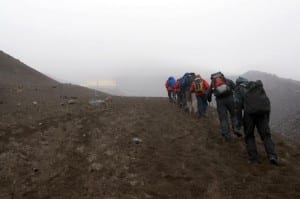Climbing Cotopaxi and Chimborazo
LiveTheLifeinEcuador | October 14, 2015
While it literally translates to “equator,” Ecuador is not all steamy rainforest jungles and sunny tropical shores. Ecuador also boasts of snowcapped mountain ranges, ice-coned volcanoes, lush, fertile valleys, and enchanting forest trails. Ecuador is definitely the outdoor enthusiast’s paradise destination for all seasons.
Ecuador is home to two volcanoes perfect for hiking and climbing: Cotopaxi and Chimborazo. These two continue to attract adventurers from all over the world, hungry to scale their heights.
Up for the adventure of your life? Here’s what you need to know first:
Cotopaxi: Snow capped in the equator

Climbing the Cotopaxi (Ecuador)
Cotopaxi is one of the world’s highest active volcanoes. Snow-capped and radially symmetrical, this stratovolcano is arguably the most popular hiking destination in the country. Climbs are scheduled, but the best months are June to July and December to January.
Scaling Cotopaxi is a bit technical, but not difficult. Don’t leave base without the checklist-complete climbing gear – crampons, ice axes, and crevasse rescue gear.
The volcano’s summit, consisting of two concentric craters, averages 675 meters in diameter at the outer rim – also the volcano’s highest point. Once over that high fence, trek leisurely down the inner crater rim, which is decorated with ice cornices and carpeted with thick snow it’s hard to believe you’re still on the equator.
Chimborazo: Ecuador’s highest point
Chimborazo is the highest point in Ecuador, and among the tallest mountains in the world. Climbing is possible all year round, but the best months are June-July and December to early January. You are well advised to set out before midnight, as warming temperatures after sunrise are known to cause rock falls.
Routes to the summit of Chimborazo include the most common one -a Class-4 climb that threads its southwest flank and requires route-finding and crevasse-crossing skills.
The more adventurous take the east route, also known as the Sun Ridge Route or Arista del Sol. A bit more challenging and technical, Sun Ridge involves mixed rock-and-ice climbing, something the amateur enthusiast can look forward to next visit.

